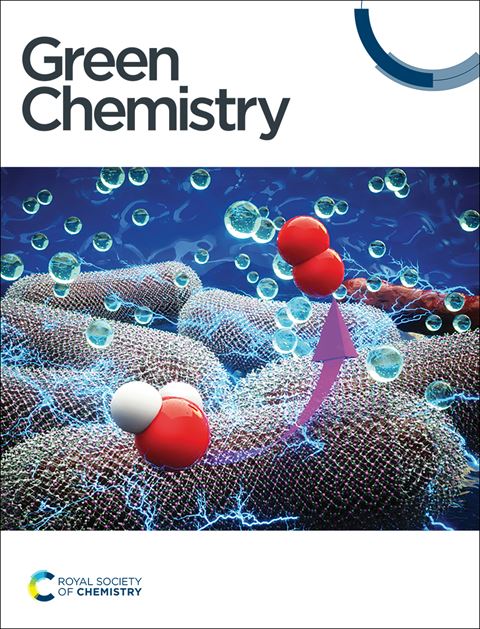Pulcherrimin: a bio-derived iron chelate catalyst for base-free oxidation of 5-hydroxymethylfurfural to furandicarboxylic acid†
IF 9.3
1区 化学
Q1 CHEMISTRY, MULTIDISCIPLINARY
引用次数: 0
Abstract
This study explores the green and sustainable catalytic properties of pulcherrimin, a naturally occurring iron chelate, for the base-free oxidation of 5-hydroxymethylfurfural (5-HMF) to high-value products such as 2,5-furandicarboxylic acid (FDCA), a vital precursor for renewable bioplastics. Pulcherrimin, derived from Metschnikowia pulcherrima, selectively oxidised 5-HMF to 5,5-diformylfuran (DFF) at 100 °C, while at 120 °C, the oxidation proceeded efficiently to FDCA with a conversion of 73.3 ± 1.1%, and FDCA selectivity of 89.0 ± 1.9% under mild, base-free conditions. Adding a mild base enhanced overall conversion but diverted the reaction pathway towards 5-hydroxymethyl-2-furancarboxylic acid (HMFCA), reducing the FDCA yield. The reusability of the pulcherrimin catalyst was tested over five reaction cycles, retaining a conversion activity of 59.1% and FDCA selectivity of 39.8%. These findings establish pulcherrimin as a promising, water-tolerant biocatalyst with potential environmental advantages, such as base-free operation and simplified product recovery, contributing to greener catalytic processes. Eliminating a homogenous base co-catalyst makes the process greener by avoiding the need for subsequent neutralisation steps while reducing environmental and economic costs.
Pulcherrimin:一种生物衍生的铁螯合催化剂,用于无碱氧化5-羟甲基糠醛生成呋喃二羧酸。
本研究探索了pulcherrimin(一种天然存在的铁螯合物)的绿色和可持续催化特性,用于无碱氧化5-羟甲基糠醛(5-HMF)生成高价值产品,如2,5-呋喃二羧酸(FDCA),这是可再生生物塑料的重要前体。Pulcherrimin,来源于Metschnikowia pulcherrima,在100℃下选择性地将5- hmf氧化为5,5-二甲酰呋喃(DFF),而在120℃下,在温和的无碱条件下,FDCA的转化率为73.3±1.1%,FDCA的选择性为89.0±1.9%。添加温和碱提高了总体转化率,但使反应途径转向5-羟甲基-2-呋喃羧酸(HMFCA),降低了FDCA的产率。在5个反应循环中测试了pulcherrimin催化剂的可重复使用性,其转化率为59.1%,FDCA选择性为39.8%。这些发现表明,pulcherrimin是一种很有前途的耐水生物催化剂,具有潜在的环境优势,如无碱操作和简化产品回收,有助于更环保的催化过程。消除均相碱助催化剂,避免了后续中和步骤,同时降低了环境和经济成本,使该过程更加环保。
本文章由计算机程序翻译,如有差异,请以英文原文为准。
求助全文
约1分钟内获得全文
求助全文
来源期刊

Green Chemistry
化学-化学综合
CiteScore
16.10
自引率
7.10%
发文量
677
审稿时长
1.4 months
期刊介绍:
Green Chemistry is a journal that provides a unique forum for the publication of innovative research on the development of alternative green and sustainable technologies. The scope of Green Chemistry is based on the definition proposed by Anastas and Warner (Green Chemistry: Theory and Practice, P T Anastas and J C Warner, Oxford University Press, Oxford, 1998), which defines green chemistry as the utilisation of a set of principles that reduces or eliminates the use or generation of hazardous substances in the design, manufacture and application of chemical products. Green Chemistry aims to reduce the environmental impact of the chemical enterprise by developing a technology base that is inherently non-toxic to living things and the environment. The journal welcomes submissions on all aspects of research relating to this endeavor and publishes original and significant cutting-edge research that is likely to be of wide general appeal. For a work to be published, it must present a significant advance in green chemistry, including a comparison with existing methods and a demonstration of advantages over those methods.
 求助内容:
求助内容: 应助结果提醒方式:
应助结果提醒方式:


